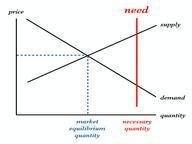Quiz Answer Key and Fun Facts
1. If the price of a normal good increases (ceteris paribus), what will happen to its demand curve?
2. What will an increase in income do to the demand curve of an inferior good (ceteris paribus)?
3. What will an increase in a price of a normal good do to its supply curve (ceteris paribus)?
4. Complete the statement: If supply decreases (ceteris paribus), the equilibrium price will ___ and the equilibrium quantity will ___.
5. Which of the following increases the demand of a normal good (ceteris paribus)?
6. The price elasticity of demand (PED) of Good X is 2.5. Good X is thus _____ .
7. If the cross elasticity of demand (CED) between goods X and Y is negative, what is probably the relation between X and Y?
8. A surplus occurs when
9. Which of the following lowers the equilibrium price (ceteris paribus)?
10. If one wishes to increase the total revenue for an inelastic good, what must he do?
Source: Author
moijer
This quiz was reviewed by FunTrivia editor
gtho4 before going online.
Any errors found in FunTrivia content are routinely corrected through our feedback system.

